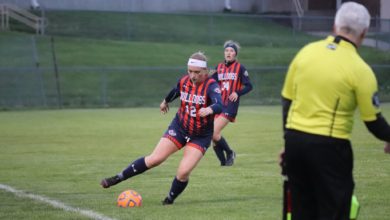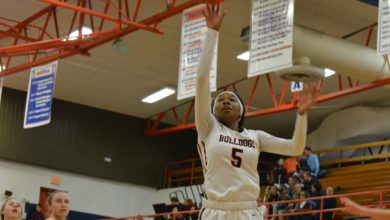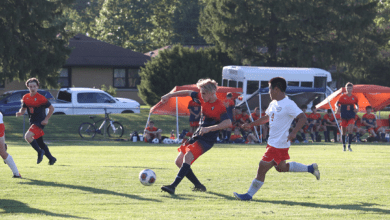Mahomet-Seymour Hall of Fame: Paul Blue
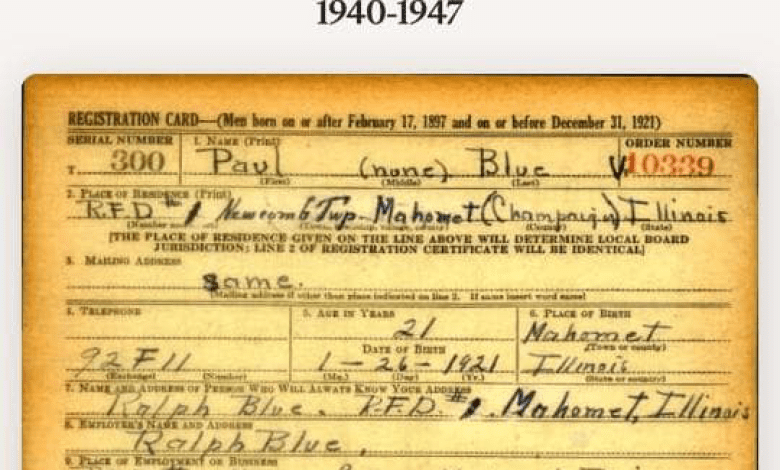
By Fred Kroner
EDITOR’S NOTE:
Four selections have been made for the Mahomet-Seymour Education Foundation Hall of Fame. This is the fourth of the four who have been profiled in recent days.
The inductees, who will be recognized on Friday, Sept. 23 before the M-S homecoming football game, are:
Paul Blue (Class of 1937)
Kendra Donley Free (Class of 2005)
Larry Gnagey (Class of 1948)
Cully Welter (Class of 1987)
By FRED KRONER
There are more certainties in life than death and taxes.
Always, there will be firsts.
The first day of school.
The first date.
The first paycheck.
The first state championship.
Mahomet High School’s first state titlist won his crown almost 85 years ago and more than a decade before Seymour was added to the district by consolidation.
In his senior year, Paul Blue captured the state high jump championship, clearing 6 feet, 1 inch in the 1937 IHSA track and field meet at the University of Illinois Memorial Stadium.
He not only was the best in the state, but also established a school record in the event that stood for 35 years until Galen Dale leaped 6 feet, 2 inches in 1972.
Blue was unbeaten in the high jump as a senior, starting with a leap of 5 feet, 9 inches in his first outdoor meet of the season.
For his efforts, which also included serving as the team captain in basketball and leading a 16-13 team in scoring as a senior, Blue will be honored posthumously as one of the latest members of the Mahomet Education Foundation Hall of Fame.
The ceremony will take place on Friday (Sept. 23), prior to the M-S homecoming football game.
After Blue’s championship leap, it took 27 years before the school district had another state champion when golfer Dan Bishop captured state honors for Mahomet-Seymour by one stroke in 1964.
It took a series of extraordinary events, however, for Blue to permanently etch his name in the record books.
His credentials were unquestioned.
In April 1937, Blue cleared a career-best 5 feet, 11 ¾ inches to win the Champaign County Meet with a record-shattering performance. The previous mark was 5 feet, 7 inches.
In the Sangamon Valley Conference meet, Blue was a multiple event winner. He rewrote the record books with a 5-feet, 10 ¾-inch leap in the high jump, shattering a standard that had stood at 5-6.
He cleared 10 feet, 4 inches to win the pole vault.
Overall that spring, Blue had eclipsed the 5 feet, 10 inch mark on four separate occasions. That was significant.
The IHSA state qualifying standards were to finish in the top two at the district meet or – on that day – match the fifth-place mark from the previous year’s state meet.
That height in the high jump was 5 feet, 10 inches.
Blue was regarded as the overwhelming individual favorite in the high jump at the 34-school district meet, which was scheduled for May 7, 1937, in Rantoul.
In a late-season meet at Farmer City, according to a report in the weekly Mahomet Sucker State, Blue “jumped over the standards and they had to set up the pole vault standards (to accurately measure his leaps).”
Pat Harmon provided in-person newspaper coverage of the one-class district meet for The News-Gazette.
He chronicled an unprecedented scenario that involved Blue, who was raised on a farm about 3 miles north of Mahomet, along Rt. 47.
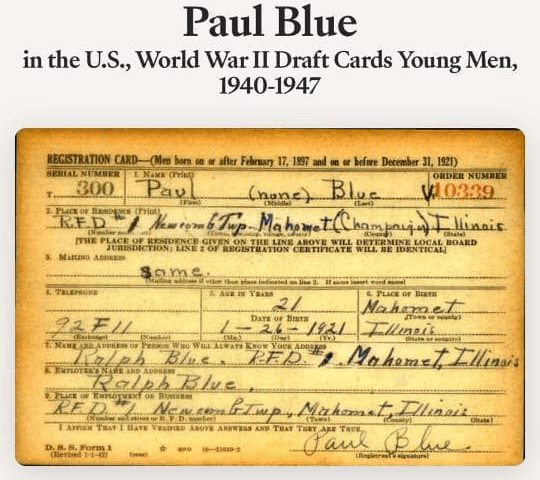
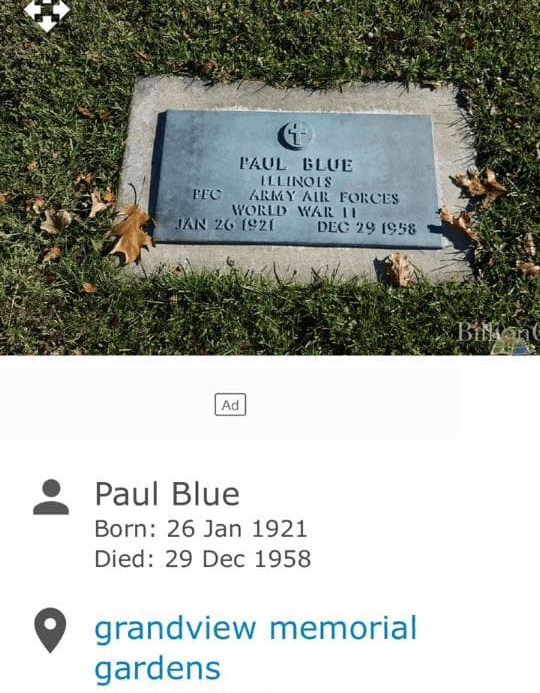
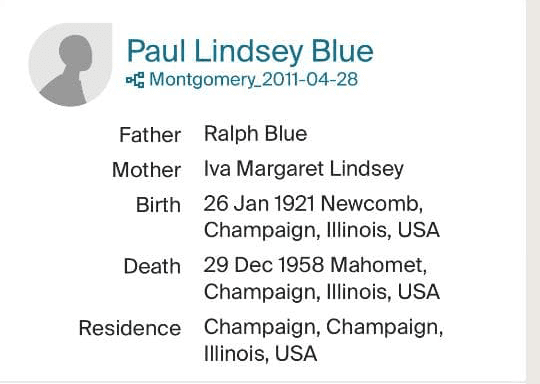
Harmon wrote:
“Paul Blue, of Mahomet, one of the five best jumpers in the state, will probably not be allowed to compete in the Illinois finals at Memorial Stadium.
“The rules state that any high school athlete who jumps 5-10 in district competition is eligible for the state finals. Through misinterpretation, Blue thought his jumps in other meets – not district – were to qualify him. He has four times surpassed 5-10.
“Consequently, the Mahomet ace failed to show for the preliminaries Friday afternoon and was scratched. When he appeared Friday night (for the finals), he was allowed to compete unofficially with the understanding that if he made 5-10 again he might get a chance in the state.
“He sailed over 5-5, 5-6 and 5-7 without an effort, but missed three times running at 5-8. Since he cleared 5-7, same height as Eugene Legge (from Hammond), first-place winner, it’s now up to Mr. (C.W.) Whitten of the state association whether or not he competes next week.”
In the modern era of journalism, there would have been multiple followups on what decision was ultimately reached, including reaction from those involved.
However, neither The News-Gazette nor the community’s other daily newspaper, The Evening Courier, made any mention of the situation in the week ahead.
The next reference of any sort was written in The News-Gazette the following Saturday (May 15, 1937) when Blue’s name was included on a list of statewide athletes who had qualified for the finals in the high jump after the preliminary round was completed on Friday.
There was no mention of the snafu at the district meet or a comment from the IHSA state director detailing reasons for Blue to be included at state.
Pure speculation, done years later, is that since Blue was allowed to compete in the district finals and matched the winning height, he gained a state berth because the top two placers automatically qualified.
Coverage in the Courier provided this insight in its state-meet wrapup:
“Paul Blue, Mahomet’s star high jumper who had to get special permission to enter the state meet, took full advantage of the boon by copping the title in his event.
“Although three jumpers tied with him at 6-1, he cleared the height on his first try while the others required more than one leap. The new rule this year (fewest misses at a height would serve as the tiebreaker) gave him his first.”
The runner-up was Dean Fair, from White Hall, who had the state’s top performance during the regular season, clearing 6 feet, 2 inches. At state, Fair made 6-1 on his second attempt and thus settled for second place at the 43rd annual state track and field meet.
Blue collected five team points for winning the high jump. That total represented Mahomet’s entire output at state and resulted in the school tying for 13th place.
In all, 178 schools had state track and field qualifiers in 1937.
In a 2017 interview, Scott Johnson from the IHSA said Blue’s fate would likely not be the same in this decade when track athletes seek state qualifying standards at a sectional meet.
Said Johnson: “The scenario would not end the same way today. A player has to qualify in the prelims to make it to the finals (on the same day) and I don’t think the excuse given in 1937 would float today.”
Mahomet’s basketball team in Blue’s senior year averaged 30.3 points per game and allowed an average of 23.1 points per game for the 29 games it played. Blue was a forward on the team and was the top scorer, although individual statistics are not available.
After high school, Blue helped his father, Ralph, on the family’s grain and livestock farm until 1941, when he served in World War II.
He was in the Army Air Forces (a precursor to the United States Air Force) and was a tail-gunner in a bomber that was shot down over France.
Blue, who was not married, died in 1958, four days after Christmas and 28 days before his 38th birthday, at 5:30 a.m. at Burnham City Hospital, in Champaign.
He was the only child of Ralph and Iva Margaret (Madge) Blue. He was survived by his father.
Blue was a member of the Mahomet Methodist Church. His obituary in the Mahomet Sucker State included this paragraph:
“He has been in poor health since the service and has spent much time in the Veteran’s Hospital in Dwight.”


